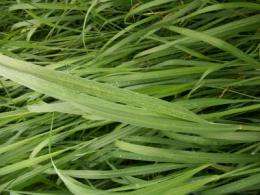Researchers discover potential new virus in switchgrass

University of Illinois researchers have confirmed the first report of a potential new virus belonging to the genus Marafivirus in switchgrass, a biomass crop being evaluated for commercial cellulosic ethanol production.
The virus is associated with mosaic and yellow streak symptoms on switchgrass leaves. This virus has the potential of reducing photosynthesis and decreasing biomass yield. Members of this genus have been known to cause severe yield losses in other crops. For example, Maize rayado fino virus (MRFV), a type member of the genus, has been reported to cause yield reductions in corn grown in Mexico, Central America and South America.
"Viral diseases are potentially significant threats to bioenergy crops such as Miscanthus x giganteus, energycane and switchgrass," said Bright Agindotan, research associate working in Carl Bradley's laboratory as part of the Energy Biosciences Institute (EBI) located in the Institute for Genomic Biology at the U of I. "Our team at EBI has been charged with identifying potential pests and pathogens of these bioenergy crops."
Until recently, little has been known about viruses in these bioenergy crops. Agindotan said most plants can be infected with multiple viruses, making it a challenge to know which viruses to start screening for, especially when only a few viruses have been reported to affect these crops.
Agindotan developed a method that allows for the identification of a virus without prior knowledge of it. He successfully used sequence-independent amplification (SIA) to identify RNA viruses. This is the first time it has been fully described and used for plant virus identification.
The method involves virus partial purification for a small amount of infected leaf tissue, extraction of viral RNA, random amplification, cloning, sequencing, and searching databases to identify the virus.
"Sequence-independent amplification has a distinct advantage over other virus characterization techniques in that it does not require specific reagents to target viruses," he said. "This test will help us specifically identify uncharacterized viruses. In other words, you don't have to know which virus you are looking for, exactly, to able to be able to identify the virus causing the problem."
The identified virus in switchgrass is different, but related to the MRFV that has been reported to infect corn elsewhere, but has never been reported in Illinois.
The Marafivirus was identified in switchgrass from a U of I research field near campus, where 20 to 30 percent of the plot was infected with this virus.
"We are still working on identifying the insects that are responsible for transmitting it," he said. "We know that its MRFV relative is transmitted by leafhoppers in corn, but we are still trying to confirm the exact species that transmit this virus in switchgrass."
At this time, researchers cannot confirm if this virus affects other crops.
"We don't yet know if the Marafivirus in switchgrass evolved from the one that infects maize or vice versa," he said.
Developing biomass crops that do not harbor pathogens that can spread to nearby cultivated food crops such as cereals is a high priority for plant breeders. This discovery will help plant breeders develop resistant varieties, Agindotan said.
The group will report the full genome sequence of the switchgrass virus soon.
More information: This study, "Application of sequence-independent amplification (SIA) for the identification of RNA viruses in bioenergy crops," was published in the Journal of Virological Methods.
Provided by University of Illinois at Urbana-Champaign
















